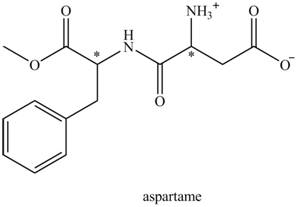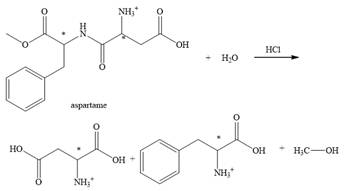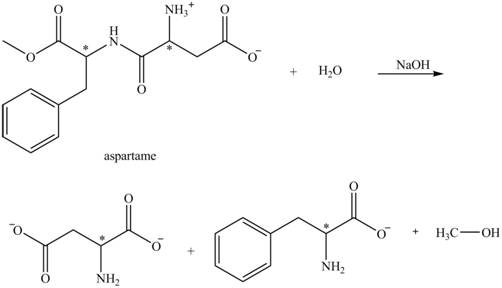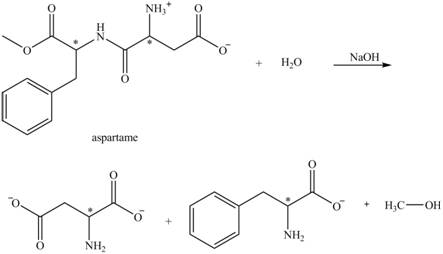
(a)
Interpretation:
The validation corresponding to the fact that aspartame is chiral is to be stated. If aspartame is chiral, then the possible number of stereoisomers for aspartame is to be stated.
Concept Introduction:
A compound that contains a chiral carbon is known as chiral compound. Carbon atom that contains all the four different atoms or group of atoms attached to it is referred as the chiral atom. This carbon is also known as stereocenter.
The possible number of stereoisomers is calculated by the expression
Answer to Problem 10P
Aspartame is a chiral compound. The possible number of stereoisomers for aspartame is
Explanation of Solution
The aspartame is a chiral compound. The structure of aspartame which contains chiral carbon atoms is shown as,

There are two chiral carbon atoms present in aspartame which are marked with asterisk sign. In the structure of aspartame, one carbon atom is directly bonded to
Thus, the possible number of stereoisomers in aspartame is,
Where,
- is the number of stereocenter.
Thus, the possible stereoisomers of aspartame is
(b)
Interpretation:
The name of each functional group present in aspartame is to be stated.
Concept Introduction:
An atom or a group of atoms that shows characteristic physical and chemical properties are collectively known as
Answer to Problem 10P
The name of each functional group present in aspartame is ester group
Explanation of Solution
According to the structure of aspartame shown in Figure 1, there are four functional groups present in the structure of aspartame.
The name of all the functional group of aspartame is ester group
(c)
Interpretation:
The net charge on aspartame molecule in an aqueous solution at
Concept Introduction:
The negative logarithm of hydrogen ion concentration of the solution is known as
Answer to Problem 10P
The net charge on aspartame molecule in an aqueous solution at
Explanation of Solution
In an aqueous solution of
Hence, there is no change of charge takes place in aspartame and it possesses zero net charge.
(d)
Interpretation:
The validation corresponding to the fact that aspartame is whether soluble in water or not is to be stated.
Concept Introduction:
According to the concept of solubility, it is mentioned that like dissolves like. Generally, polar compound can only be dissolved in polar solvents and non-polar or weakly polar compounds can only be dissolved in non-polar solvents or weakly polar solvents.
Answer to Problem 10P
Aspartame is soluble in water.
Explanation of Solution
The given structure of asparatame is present in zwitterion form which suggests that it is a polar molecule. According to the concept of like dissolves like, aspartame is soluble in water because water is also a polar molecule.
(e)
Interpretation:
The structural formulas for the products that are obtained by the complete hydrolysis of aspartame in aqueous
Concept Introduction:
An atom or a group of atoms that shows characteristic physical and chemical properties are collectively known as functional groups. The functional group is the most reactive part present in the molecule. The main functional groups are
The addition of water molecule to the compound is known as hydrolysis that compound.
Answer to Problem 10P
The structural formulas for the products that are obtained by the complete hydrolysis of aspartame in aqueous

Explanation of Solution
The hydrolysis of aspartame in the presence of aqueous

Figure 2.
The reaction of aspartame with aqueous
(f)
Interpretation:
The structural formulas for the products that are obtained by the complete hydrolysis of aspartame in aqueous
Concept Introduction:
An atom or a group of atoms that shows characteristic physical and chemical properties are collectively known as functional groups. The functional group is the most reactive part present in the molecule. The main functional groups are
The addition of water molecule to the compound is known as hydrolysis that compound.
Answer to Problem 10P
The structural formulas for the products that are obtained by the complete hydrolysis of aspartame in aqueous

Explanation of Solution
The hydrolysis of aspartame in the presence of aqueous

Figure 3.
The reaction of aspartame with aqueous
Want to see more full solutions like this?
Chapter 18 Solutions
Introduction To General, Organic, And Biochemistry
- (a) Draw the nine isomers having the formula C7H16 . (Hint: There is one structure with a seven-carbon chain, two structures with six-carbon chains [one is illustrated in the margin above], five structures with a five-carbon chain, and one structure with a fourcarbon chain.)(b) Identify the isomers of C7H16 that are chiral.arrow_forwardFor cis-1,3-diethylcyciobutane, draw (a) a stereoisomer; (b) a constitutional isomer.arrow_forwardDraw structures from the following names, and determine which compounds are optically active:(a) 1,3-dichloropentane (b) 3-chloro-2,2,5-trimethylhexane(c) 1-bromo-1-chlorobutanearrow_forward
- a) Give the chemical structure for each of the following compound: (i) 4-hydroxybenzoic acid (ii) 2-hexene (iii) chlorocyclohexane (iv) 2,5-dichloroheptane b) Prostaglandin are a group of C20 lipids and can be found in small amounts in all body tissues and fluids. (1) Put an asterisk on all the chiral carbon(s) present in the chemical structure of prostaglandin E. (II) Do you expect prostaglandin to be acidic or basic? (III) Circle the functional group that is responsible for the acidity / basicity. ali se odno HO OH HO Prostaglandin Earrow_forwardDraw structures corresponding to the following names:(a) 3,4-Dimethylhexanoic acid(b) Phenylacetic acid(c) 3,4-Dinitrobenzoic acid(d) Triethylammonium butanoatearrow_forwardDraw structures corresponding to the following IUPAC names: (a) cis-1,2-Cyclohexanedicarboxylic acid (b) Heptanedioic acid (c) 2-Hexen-4-ynoic acidarrow_forward
- Draw structures from the following names, and determinewhich compounds are optically active:(a) 1,3-dichloropentane(b) 3-chloro-2,2,5-trimethylhexane(c) 1-bromo-1-chlorobutanearrow_forward(4) Write the structure of the following compounds from their IUPAC names. (a) ethanamide (b) methylethanoate (c) propanoic acid (d) 2-butanone (5) Write the structure of the following ethers and amines from their common names (a) methyl propyl (b) trimethylamine (6) Decide whether the following alcohols are polar or nonpolar (a) CH3CH2CH2CH2CH2CH2CH2OH (b) CH3CH2OHarrow_forwardDraw structures corresponding to the following names:(a) 2,2,3-Trifluorobutanoic acid(b) 3-Hydroxybutanoic acid(c) 3,3-Dimethyl-4-phenylpentanoic acidarrow_forward
- Determine (A.) functional groups presents in the molecules and (B) determine the number of chiral carbons in the molecule (Exclude alkane) (Hint: Only 5 functional groups available)arrow_forward5. Give the structural formulae and name the functional groups of the following compounds. (a) 3-chlorobut-1-ene (b) butanedioic acid Name the functional group: (c) propanamide Name the functional group: (d) 3-methylbutanal Name the functional group: Name the functional group:arrow_forward3. Draw structures for the following: (a) an acid and an ester having the formula C 2 H 4O 2 (b) 2-alkenes having the formula C 5H 10 (3 isomers) (c) 1° amines having the formula C 4 H 11 N (4 isomers)arrow_forward
 Organic ChemistryChemistryISBN:9781305580350Author:William H. Brown, Brent L. Iverson, Eric Anslyn, Christopher S. FootePublisher:Cengage LearningChemistry: Matter and ChangeChemistryISBN:9780078746376Author:Dinah Zike, Laurel Dingrando, Nicholas Hainen, Cheryl WistromPublisher:Glencoe/McGraw-Hill School Pub Co
Organic ChemistryChemistryISBN:9781305580350Author:William H. Brown, Brent L. Iverson, Eric Anslyn, Christopher S. FootePublisher:Cengage LearningChemistry: Matter and ChangeChemistryISBN:9780078746376Author:Dinah Zike, Laurel Dingrando, Nicholas Hainen, Cheryl WistromPublisher:Glencoe/McGraw-Hill School Pub Co Chemistry: Principles and PracticeChemistryISBN:9780534420123Author:Daniel L. Reger, Scott R. Goode, David W. Ball, Edward MercerPublisher:Cengage Learning
Chemistry: Principles and PracticeChemistryISBN:9780534420123Author:Daniel L. Reger, Scott R. Goode, David W. Ball, Edward MercerPublisher:Cengage Learning


